China
3 Chapter Investment Environment
-
-
1 Chapter Introduction
1.1 The history of Japanese companies entering the world
1.2 New business model in China
1.3 Advance scheme through Hong Kong
2 Chapter Basic knowledge
3 Chapter Investment Environment
3.2 Province and region of China
3.5 Investment incentives and regulations
4 Chapter Economic Environment
5 Chapter Establishment
5.3 Establishment of business base
5.4 Procedure after incorporation
6 Chapter Withdraw
7 Chapter Foreign exchange
7.1 Foreign exchange management system in China
7.2 Foreign currency management system of ordinary items
7.3 Foreign exchange control system of capital items
7.4 Foreign exchange control system in bonded area · Hong Kong
7.5 Individual foreign currency control system
8 Chapter M&A
8.2 Laws and regulations concerning M & A
8.5 Challenges after corporate acquisition
9 Chapter Corporate Laws
10 Chapter Accounting
11 Chapter Tax law
11.2 Representative Office Taxation
11.4 Individual Issues in China Domestic Tax Law
12 Chapter International taxation strategy
12.1 International tax relating to entering China
12.2 International taxation strategy
12.3 Individual Issues in International Taxation
12.4 Tax issues related to withdrawal
13 Chapter Transfer Price Taxation
13.2 Individual provision pertaining to transfer pricing taxation
13.3 Transfer price taxation and documentation
13.4 Transfer price survey in China
14 Chapter Labor
14.4 Points to remember when bringing Japanese
15 Chapter International Human Resources Management
15.1 Human Resources Labor Management
15.3 Personnel evaluation system
-
-
-
Latest News & Updates
【7 days no reason for return purchase provisional valuation method for purchased items on internet】
In China, the EC market is very developed like Tao Bao, but trouble between seller and consumer has remained constant. Meanwhile, on January 6, 2017, "7 day no-reason return goods provisional valuation method on the Internet" "provisional merchandise seven days free reason reasonable way" is promulgated, enforced on March 15, 2017 It will be.
▸ Background
According to the revision of the Consumer Rights Interest Protection Law in 2013, it was stipulated that for the purchase on the Internet (Taobao etc.), 7 days have the right to return without a reason. However, because there is no specific description of scope of application etc., disputes over the return of goods occurred frequently.
▸ Content
"Scope of application"
The following goods do not apply for 7 days no reason return. (Article 6)
1) Special order
2) Raw and rotten products
3) What to download online. Or a digital product such as a sound image product, computer software, etc. opened by a consumer
4) Newspaper, periodicals
In addition, the following items cannot be applied for 7 days no reason returned goods by confirmation at the time of purchase by consumers. (Article 7)
1) Items that affect safety or health after opening, products whose quality changes
2) Products that greatly reduce value when launched or tried
3) Goods with quality assurance period approaching at the time of sale, goods with defects.
"Condition of return"
In order to return it, the product must be in perfect condition. The complete state means that the product has the original quality and function, and the product main body, accessories, and trademarks are all included. For example, when opening the package of goods for confirmation, it will not damage the complete state of the product.
"Return procedure"
You need to notify the seller of the return within seven days from the date you received the item. In addition, 7 days is calculated from the next day the product is received by the consumer. -
The China’s investment environment has seen in the business questionnaire
The World Bank and the International Finance Corporation (IFC) have jointly announced the current status of business environment for the year 2015. Based on the results of this questionnaire, we will look at the evaluation of the world to the country of China.
China ranked as the 90th of the business environment – ranking in 189 countries and regions, and ranking six from the previous year. The countries such as Russia is in the 62nd place, Brazil in the 120th place, India in the 142st place, and China, which was at the highest rank in BRICS until 2013, it was ranked second in Russia by 2015. Japan is ranked 29th and South Korea is fifth, and this shows that the investment environment in East Asia is one step ahead of BRICS.
In the ranking of 2015, China is ranked higher than the overall ranking, and there are four items that is important: performance of contract, registration of real estate, withdrawal of business and financing.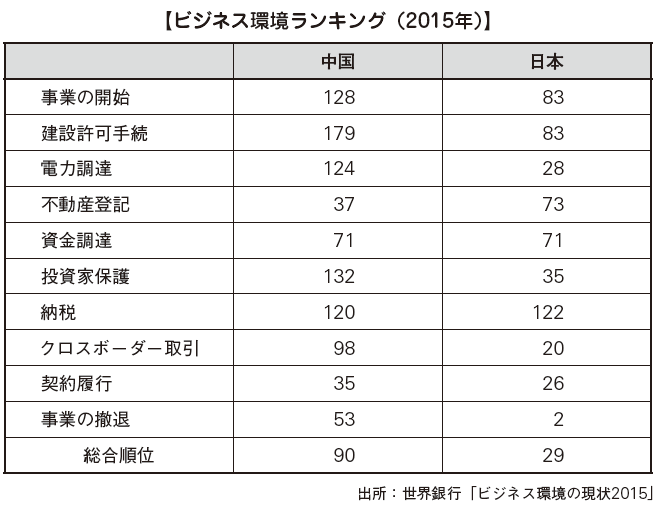
-
Financial (stock) market
The Chinese stock exchanges are located in Shanghai, Shenzhen City, Guangdong Province, of Hong Kong. The total market capitalization of listed companies as of December 2013 is rated as world's top 7 with the US $ 2,497 billion at the Shanghai Stock Exchange and it’s market size of 11th at the Shenzhen Stock Exchange of US $ 1,425.2 billion.
The following graph shows the trend of Shanghai comprehensive index, which published by the Shanghai Stock Exchange. Shanghai comprehensive index is 100 in 1990, which is linked to both RMB denominated Shares A and foreign currency denominated B shares. After reaching 3,400 points in July 2009 after the global financial crisis, we have reached an adjustment phase due to concerns about monetary tightening and deteriorating demand to curb inflation. After the timing of the departure from the financial crisis measures and the shift of the growth strategy, it is now recovered.
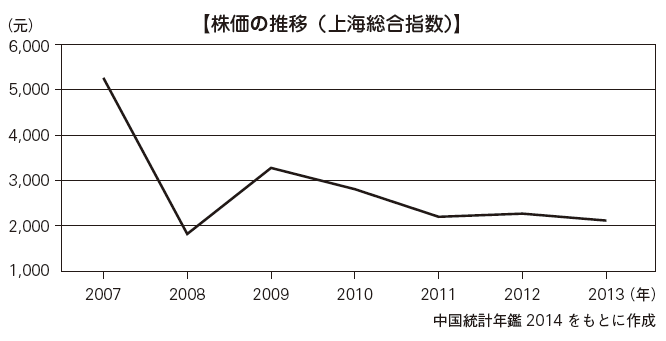
-
Exchange rate
Although the original value, and the currency of the Chinese yuan (RMB), should have risen with its high economic growth, only the original value has been rising. If the People's Bank of China intervened in the exchange market, one dollar (1$) = 8.28 Yuan that is why they kept pushing economic growth.
However, in the year of 2005, the Chinese Government introduced a
In 2005, however, the Chinese government introduced a currency system and renewed the remnibi as a official currency of the People’s Republic of China. As a result, the reserve value of foreign exchange reserves in China has expanded and has surpassed Japan in the latter half of the 2000s and is ranked number one in the world.
The terms of the relationship between the Japanese Yen and the Chinese Yen, it has been progressing rapidly since the 6th month of the year 2012. Considering the influence on exports, the Chinese government will continue to continue the currency intervention in order to avoid any circumstances.
It is expected that the revaluation of the renminbi will continue to remain due to reason such as the fact that it is a diplomacy card against overseas pressure and some extraordinary heights have to be accepted due to domestic inflation concerns.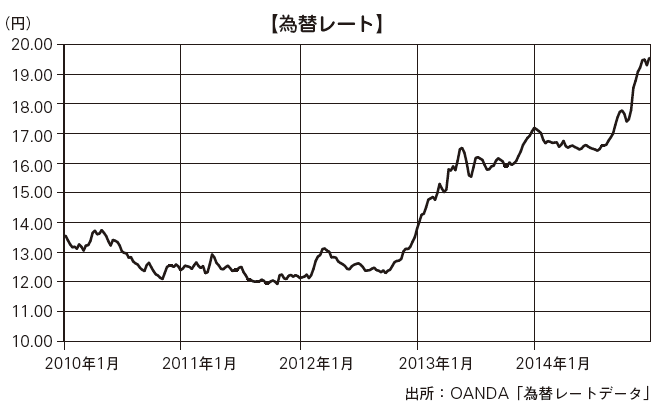
-
Foreign direct investment amount (FDI)
Foreign direct investment (FDI) in China has been increasing 1.3 percent year on year in January to May 2018 and has been doubled in the past 10 years. By country or region, Hong Kong is overwhelmingly the top spot in the direct investment next to America, Japan and Kazakhstan.
The reason of the rapid increase of FDI of Chin is due to its high economic growth with this, the investment production base was actively carried out, and the per capita GDP China in the year 1980 was about five times that in 2000.
In recent years, China has been regarded as a huge market and aggressive market development is being carried out. The FDI which once fell in the global financial crisis also recovered in 2010 and was steady in 2011, but the impact of the global recession triggered by the European fiscal crisis was deeply rooted, somewhat weak in 2012,
The ratio became negative. Although future expansion of domestic demand is expected, there is uncertainty about the future trend of the global economic situation, and continued gaze is necessary.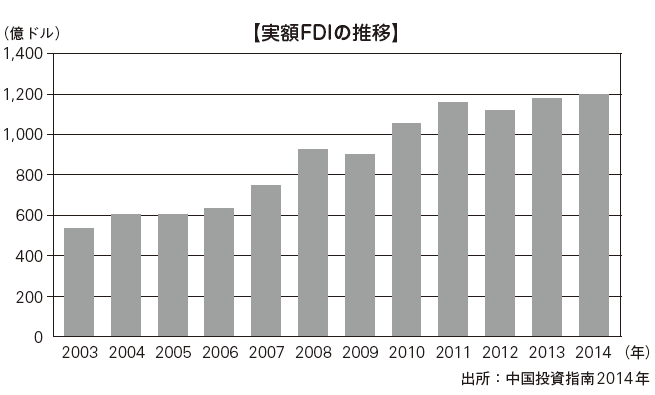
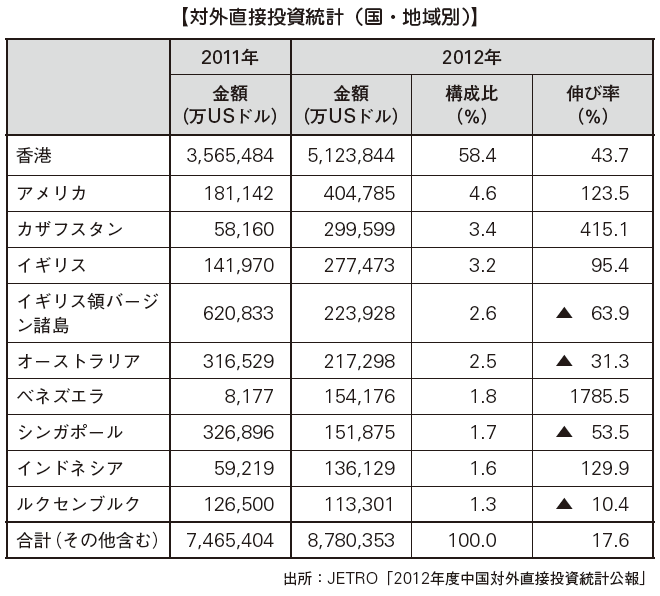
-
Infrastructure
According to the World Economic Forum's "The Global Competitiveness Report 2013-2014", the ranking of infrastructure development in China ranks 74th among 144 countries. India is 85th, Russia 93th, Brazil 114th, and infrastructure improvement is progressing more than other BRICS countries.
In the East Asia region, Japan is ranked 14th, while Korea is 23rd, Taiwan is 26th, Thailand is 61st, and the Chinese government is focusing on further infrastructure improvement.
According to the report, the rank is 54th and the railway is 20th compared to the growth rate of economy and GDP per capita, and it seems that the improvement of transportation infrastructure was advanced earlier.
■Road Extension
China is a vast country especially in road constructions and such. The country’s road extension distance is 4,010,000 km (as of 2010) and is the third largest in the world after the United States and India, but the road paving rate is low at 53.5%, which is only ranked 60th.
However, road infrastructure development is rapidly progressed but the most important issue is that the automobile sales of Chin is now the world’s largest and the reduction of disparity between urban and rural areas has been set as a national policy.
According to the medium- to long-term plan announced by the State Council of China in 2005, the highway network linking cities and cities will be quadrupled by the year 2035 to cities all over 200,000 inhabitants.
In the five-year plan of infrastructure development from 2011 to 2015, the total extended distance of the expressway will be from 74,000 km to 108,000 km, which is expected to exceed the longest in the world. By doing this, not only roads in metropolitan areas will develop but also the road networks from regions including inland areas.
In the future, there are new issues to face such as the improvement of software aspects such s the traffic management system and the creation of huge expenses related to the maintenance of large extension of road facilities.
The construction of a transportation network that crosses the border is also an important issue due to China borders the country of Russia, Mongolia in the north, Kazakhstan in the west, Pakistan in the west, India in the southwest, Nepal in the south. With this, the Asian International Highways are on plan due to its increasing the interest of the people.
■ Railway
The total length of railway extension in China is 112,000 km (as of 2014), which is the third largest in the world after America and Russia.
The high-speed railway linking cities to cities, and the development of the subway in large cities such as Shanghai have been improving and the construction of the subway has already been approved in 33 cities, specifically under planning or construction.
In Shanghai, the business distance as of 2009 was 410 km, and it became the city which has the world's largest subway network over London. The Beijing subway is about 200 km long and there are also lines under planning, so further improvement will be expected in the future.
The improvement of the Western Development is not only in coastal areas but also in inland areas. The cooperation with the coastal areas had been strengthen throughout the construction of a railway centered on inland large cities such as Chongqing and Chengdu, and the trade with Yunnan Province and the Southeast Asian countries in the Mekong had been flourished.
That is why we are contributing greatly to expand the trade through Guangdong province and Hong Kong and as a distortion of the rapid expansion of railway infrastructure, there are shortage of know-how on management and problems of vulnerable safety management due to the incident happened in Zhejiang province in November 2011 where accident happened when there is a collision or derailment accident of 40 high-risk railroads.
That is why one of the things they prioritize is the improvement of the services and congestion.
■ Port
In China there are over 120 ports, including river ports, to handle import and export cargo and passenger entry and departure ports. Main ports to open to the outside are Dalian, Tianjin, Qingdao, Shanghai and Ningbo in the eastern province, Guangzhou and Shenzhen in the South China region facing the Bohai Bay. Ningbo - Zhoushan Port has been rapidly increasing over the past few years, followed by Shanghai and Tianjin, and this port is a large port facility with more than 100 number of installed 10,000 - ton berths.
In 2012 the Shanghai Port is 32,570,000 TEU (20 ft container equivalent), surpassing Singapore and becoming the top in the world. In addition, Shenzhen, Ningbo, Guangzhou, Qingdao and Tianjin are among the world's top ten most important ports in China.
In Shanghai, "Yangshan deep-water port ward project" to construct a deep-water port by landfilling the island located 30 km from Pudong New District is proceeding because the port of Pudong New Area will be difficult to deal with large ships due to Yangtze volume sediment I will. It is scheduled to be completed in 2020, becoming the world's largest container port when completed.
■Airport
The airport in China have three major international airports as regional hubs and international hub airports such as Beijing Airport, Shanghai Pudong Airport and Guangzhou Baiyun Airport.
It is an airport where many regular flights to Asia, Europe and the United States are in service, but it also functions as a hub base in North China, East China, South China.
The management system is highly attentive and fast that is why whenever there’s a situation, we can process many logistics quickly with function.
The international flights are in service whether it is around the cities or in country especially when the Asian countries are crowded with many direct flights.
The number of passengers using aircraft rapidly increased with economic growth. For this reason, especially in urban areas centered on coastal areas, airport facilities are being revamped and new airport construction is actively proceeding, and construction of new airports in Beijing is proceeding. On the other hand, inland areas do not have airports.
The Chinese government invests 1.5 trillion yuan (about 19 trillion yen) of airport infrastructure from 2010 to 2015 and aims to achieve balanced growth by strengthening domestic distribution including the inland area.
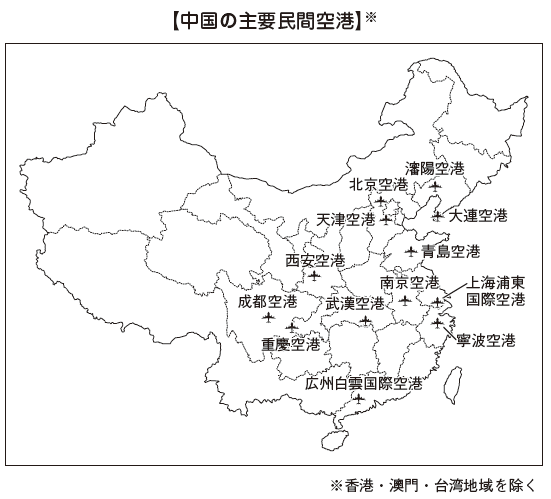
■PowerIn the year 1980s, Chin was a net exporter of energy but was change to net imported in the 1990.
In addition to abundant energy resources in Japan, we are importing large quantities of crude oil and natural gas and striving to ensure stable supply of electricity. According to the table below, we can see that both the production and consumption of electricity in China are rapidly increasing due to strongly promoting the energy diplomacy as a national policy, that we have taken the power supply stabilization supply as an industrial infrastructure ahead of economic growth a national policy, actively work not only to establish a new power plant but also infrastructure such as electricity transmission network Relatively stable power supply has become possible due to what was done. The Chinese government expects that the growth of electricity consumption will be somewhat slowed down, but still expects electricity consumption to be around 7,700 billion kw / h in 2020, a more stable supply base We are stating that we will arrange.
In recent years, we have been transforming both the supply and consumption of energy, from the economy of mass energy consumption type to a society that emphasizes efficiency and rapid development of new energy sources such as nuclear power and wind power and hs been accelerating ever since.
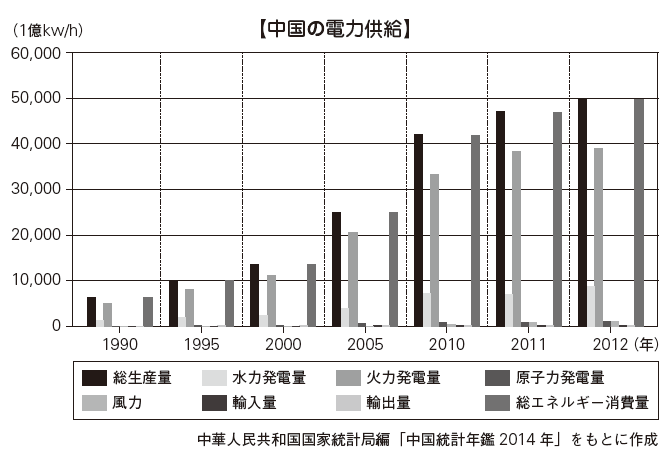
■Communication
The number of users of mobile phones in China exceeds in 800 million, and mobile phones outperform both fixed and mobile phones in both subscribers and penetration rates.
The number of Internet users in China is already over 500 million, of which about 400 million broadband users and over 300 million mobile users on mobile. Although there are problems of strict information regulation such as large regional disparity and not being able to speak freely on information on censorship on the Internet, the development of the network is almost in place.
In 2002, the former China Telecom was divided into two companies, the southern part was controlled by China Telecom and the north part was controlled by China Netcom, but the inter-Korean mutual problem was not solved. In recent years, it has been set to eliminate it by establishing data centers connecting the northern and southern parts.
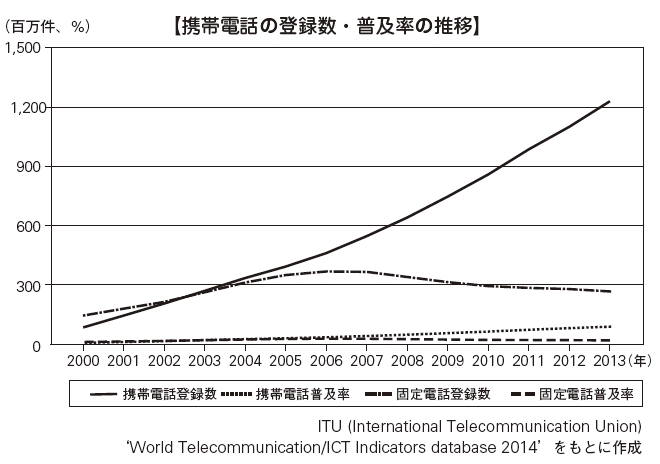
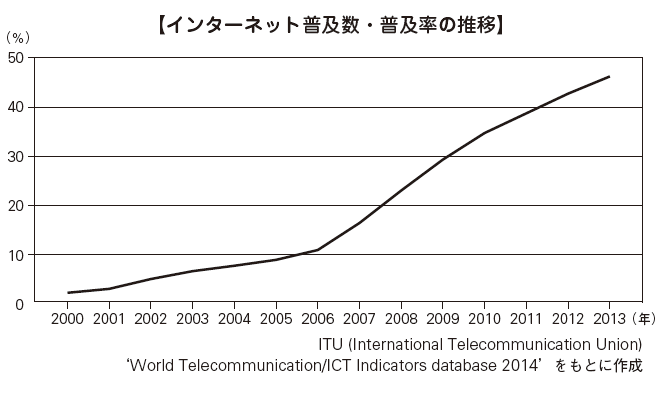
-
-
-
Province and region of China
The main provinces and areas of China are as follows.
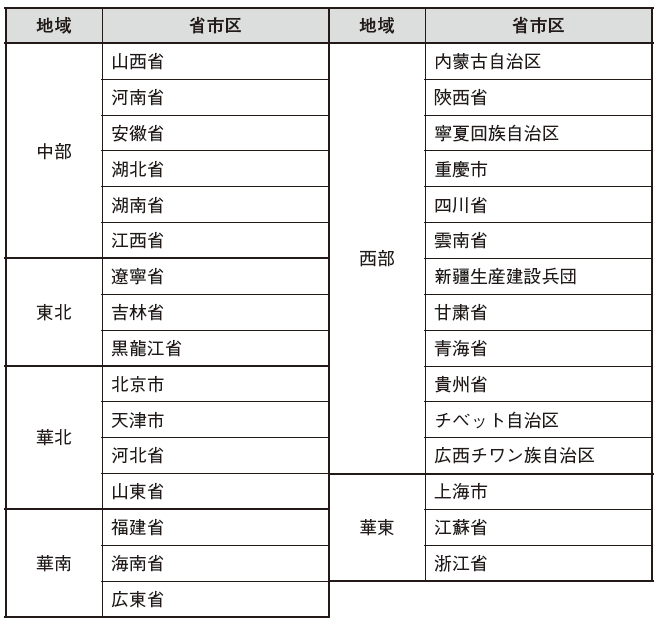
The Chubu region and the Western region are called Next Frontier, boasting economic growth beyond the eastern region.
The Chubu region is an area that is currently given preferential treatment, especially from the government. In the Chubu region, cereal production is thriving and rich in mineral resources such as coal, nonferrous metals and rare earths. "Three bases" of nationwide food production base, energy raw material bases, advanced facility manufacturing and high-tech industrial bases and a bridge between the eastern region and the western region, which is a comprehensive transportation hub connecting the north and south, "a single hub" The development of the Chubu region accelerated by advocating. Based on these geographical features and resource availability status, the Chubu region has a concept of regional promotion, which is superior to other regions in this respect.
According to the Midwest Regional Industry Inventory of Industry Preferred Industries (revised May 2013), operations that fall under non-encouraged classes in other areas may be included in encouragement classes in the Midwest. The Midwest has developed as a receptacle for industrial relocation. For example, in East China area, personnel expenses and land fee etc. are rising, and the manufacturing industry etc. is moving to the Chubu region more and more cases.
The western regional development strategy has been taken by the government since 2000, and the development of large-scale infrastructure is proceeding. In addition, the 12th Five-Year Plan was adopted in January 2012. Acceleration and superiority of infrastructure construction The development of industries and modern agriculture plays a part of the growth plan of the Chinese economy. Specific plan contents are as follows.
· Appropriate guidance to subjectivity function districts such as priority economic zones, agricultural zones, and environmental protection zones
· Accelerate the development of infrastructure that focused on transportation and irrigation facilities
· Strengthen environmental protection
· Development of distinctive advantage industries such as national energy base and resource processing base construction
· Acceleration of modern agricultural development
· Improvement of city standard of living
· Preferential educational development and expansion of employment and equalization of public services
· Promotion of industrial development through expansion of market openness -
Open to the public
In China, open policy was decided at the third general conference of the 11 th Central Committee of the Chinese Communist Party in December 1978, and the introduction of foreign capital was concretely started. Currently there are four economic special promotion zones in China.
■Special economic zone
As the first economic special promotion zone in China, special economic zones (special economic zones) were established in the four cities of Shenzhen, Zhuhai, Shantou, Xiamen in July 1979.
Foreign enterprises and foreign-invested enterprises' income tax laws that had been enforced for foreign capital until 2007 had applied a significant preferential tax rate of 10% to 15% for foreign capital for each open area . However, due to the new corporate income tax law that came into force in January 2008, the corporate income tax rate of internal and foreign capital was raised step by step, and it was unified into 25%. Furthermore, we abolish the preferential policies according to open areas to foreign capital, exempt enterprise income tax for the first one or two years by domestic emphasis such as high-tech, energy saving, environment etc, such as high-tech, energy saving, environment, etc and reduce tax to 50% for 3-5 years , Or to apply preferential policies such as keeping corporate income tax at 15% for three years.
■ Economic and Technological Development Zone
The Economic and Technological Development Zone is an industrial area established to further promote openness to the outside, and incentives similar to special economic zones are given. It was mainly a strategy aimed at attracting productivity companies, technology consolidation companies, and export processing enterprises.
In May 1984, open coastal cities (14 cities including Shanghai, Tianjin, Dalian etc.) were designated, and in September the same year, 14 economic technology development zones were established in 12 cities except Wenzhou and North Sea. Thereafter, many cities including Wenzhou, North Sea and the inland area are designated as economic and technological development zones, and as of December 2014 there are 218 same districts. In 2008 the income tax was raised to 25%.
■ Coastal economic open district
In February 1985, the coastal economic open zone was designated in the area such as the Yangtze River Delta and the Pearl River Delta to promote the economic development of the coastal area and the spread of economic development to the inland area. Tax preferential policies are adopted for productivity companies, scientific research project companies, energy, transportation, port and knowledge intensive projects.
■ Advanced New Technology Industrial Development Zone
By the State Council's "Notice on Advanced New Technology Industrial Development Zones and Related Policy Regulations" issued by the State Council (promulgated in March 1991), 27 domestic regions were designated as Advanced High Technology Development Zone (Hi-Tech Industrial Development Zone).
As of 2015, 88 places are designated and Infrastructure such as roads, communications, electric machinery, gas, water supply and sewerage, drainage facilities etc. has been established for the purpose of attracting companies, tax incentives are given, and management service system is in place.
The high-tech industrial development zone includes the software development of China called Software Park and the national industrial base indispensable for economic development supporting industry strategy support for outsourcing. As a software park, there are now Dalian Software Park (DLSP: Dalian Soft Garden), Wuhan Park, Suzhou Park. Among them, the DLSP built for the first time a park management model of "government assistance, civil servitude", a government support civil administration ceremony. Its role is not only software but also the development of industries such as aviation, hotels, finance, education and real estate, and it is creating great social value. As a result, DLSP has become an international science park where industry, education, housing and entertainment facilities became one. Furthermore, in line with the momentum of relocation of China in the service industry around the world, we are concerned with the economic development and quality improvement of cities and areas.
■ Free zone
The bonded zone is an economic trading area that conducts special management prescribed by the bonded area regulations. Except for cargoes that the country prohibits imports and exports and cargoes with other special provisions, freight can be freely imported and exported from overseas, collection of customs duties and importing stages, examination of permit documents, ordinary customs supervisory procedures It will be exempt. The import stage tax in this case refers to incremental taxes and consumption taxes. For details, please refer to "Bonded system".
■ Shanghai Free Trade Zone
In July 2013, the Shanghai Free Trade Area District Law was passed, and the Shanghai Free Trade Zone was established that allows the deregulation of foreign companies and liberalization of RMB trading more than the past development zones. The background of Shanghai Free Trade Zone was largely influenced by changes in China's domestic economic situation and changes in the trade environment surrounding the world.
Economic growth in China slowed down since 2008, while labor cost continued to rise above 10% per annum, labor-intensive industries and processed industries have ceased to exist. From the industry that depends on low cost, it becomes necessary to shift to high value added industry and service industry. In addition, the switch to free trade has been actively discussed all over the world, and China has had to proceed with infrastructure development to make free trade more. Therefore, we decided to open the Shanghai Free Trade Area on a trial basis.
To establish the bill, there is also the aim of attracting high value added industries etc from the Shanghai Free Trade Zone as starting point, and establishing the structure of China's own participation in TPP (Pacific Rim Strategic Economic Partnership Agreement).
Shanghai Free Trade Zone is not a newly developed trade zone where it consists of existing Shanghai Comprehensive Bonded Area etc. (Outer Takahashi Bonded Zone, Outer Takahashi Logistics Park District, Yangshan Bonded Port Area, Pudong Airport Comprehensive Bonded Area etc.) and the specific policy contents are as follows.
Expansion of investment field of foreign companies
Foreign enterprises will also be allowed to set up areas where establishment was restricted (foreign-owned and independent international ship management company, foreign investment credit research company, foreign-funded independent medical institution etc.). For other industries, restrictive measures such as investor requirements and restrictions on investment ratio will be suspended or abolished.
Simplification of company establishment procedures
The company establishment procedure is also simplified. With regard to the establishment of foreign invested enterprises in the priority areas of the promotion category, permits and the modern service industry to be opened in the future, review and approval of contracts and articles of incorporation become unnecessary and will change to the notification system.
Preferential treatment of corporate income tax
The enterprise income tax incentive measures will be applied to those entering the enterprise. Chinese enterprise income tax is usually 25%, but the tax rate of enterprises meeting certain requirements will be 15%.
Liberalization of RMB transactions · Bank interest rates
We can enjoy the benefits of liberalization of RMB capital items, liberalization of interest rates, precedence of RMB cross-border use, opening up the financial system to the outside world. Currently, foreign exchange control in bonded areas is handled in the same way as outside the area, but in Shanghai Free Trade Zone more flexible measures (simplification of RMB settlement procedure, etc.) are adopted.
Simplification of trade procedures
Procedures for importing and exporting cargo through Shanghai Free Trade Zone will be simplified. Until now Shanghai Sogo Free Trade Zone was strictly managed not only within the boundary with the outside of the district but also on the cargo entering and leaving the border line, even within the ward. In the future, in the Shanghai Free Trade Zone, it will be changed to a method to manage only the boundary line with the outside of the free trade zone. As a result, procedures for notification registration etc. are not required for cargo storage and movement within the ward.
-
-
-
Bonded System
The bonded-system’s purpose is to temporarily reserve imported goods and goods under taxation by customs authorities. The bonded system and processing trade are closely related. Processing trade is the business of processing and assembling all or part of raw materials and parts etc imported by a company as bonded handling in China and exporting it as a product or semi-finished product.
In order to do trade, it has to acquire foreign trade management rights by notifying and registering at the institution entrusted by the Ministry of Commerce, based on the Register of Foreign Trade Managers Registered in 2004 not.
■ Construction of the bonded system
Besides processing trading, there are bonded warehouses etc. and bonded areas as closely related to the bonded system. The contents of each transaction and the tax incentive system are as shown in the table below.
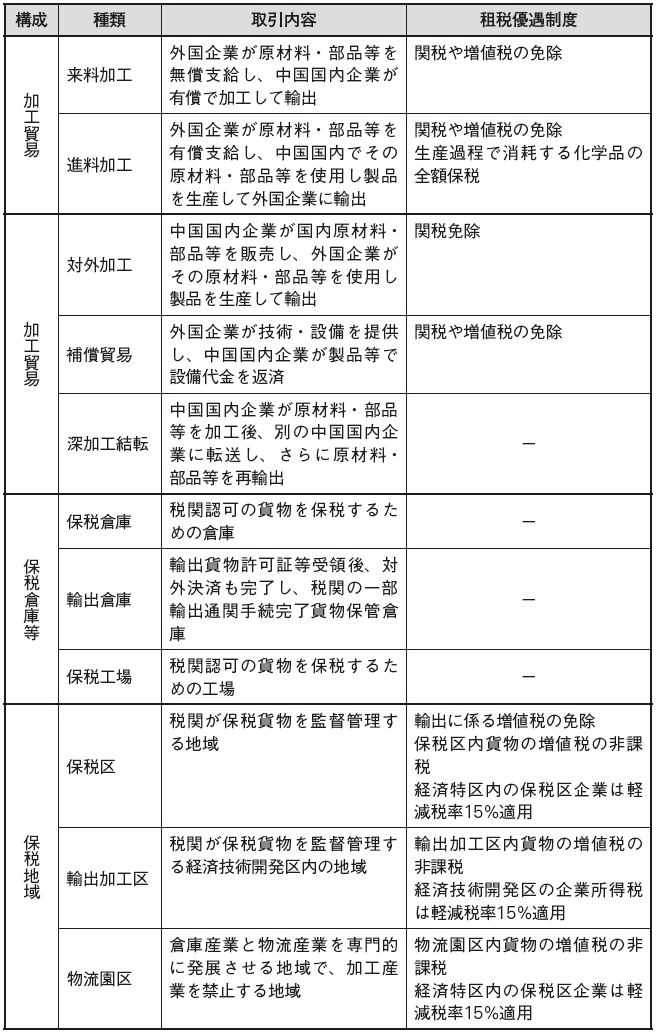
■ Processing trade guarantee money system and bank guarantee ledger system
In processing trade imported raw materials and production facilities are bonded. It is necessary to deposit the amount equivalent to tax (customs duty / value added tax) as a deposit and deposit it at customs (processing trade guarantee money system). There is also a system (bank guarantee ledger system) that reconciles and manages imported raw materials and exported goods with the bank guarantee ledger issued at the branch of the Bank of China designated by the enterprise and converts it to actual deposit. In the bank guarantee ledger system, although it is possible to apply the ledger management application to the actual form of deposit with the customs for each import declaration, the guarantee money equivalent to the actual tariff / value added tax by the custom classification rank of the company, industrial classification etc. There are two types of spinning type that do not require actual deposit deposit.
■ Bonded area
[Free zone]
The bonded zone is defined by the bonded area regulations and refers to a specific economic trading area that is authorized by the State Council and where the customs control is special. There are 13 bonded zones below.
The role of the bonded zone is to freely carry in and out between the bonded zone and the foreign country, except for cargoes that have import bans and special provisions of the country. Here we are exempted from the import stage tax, the permit inspection document and the customs supervision and management procedure which refer to customs duty / value-added tax and consumption tax.
The bonded area has advantages such as expansion of freedom of foreign currency management, expansion of tax exemption range of customs duty and value added tax, expansion of freedom of foreign currency settlement, establishment of a trading company. In bonded areas, business such as import and export trade, relay trade, processing trade, cargo warehouse, cargo shipping, product presentation, commodity trading, finance etc. are permitted.
The companies in the bonded area are exempt from import / export assignment and import / export permit issuance, and trade between bonded zones, including trade in bonded zones, and import and export trade of non-bonded area companies are allowed.
The following table shows the preferential policies of the bonded zone, but it is necessary to deal with each bonded zone for actual entry.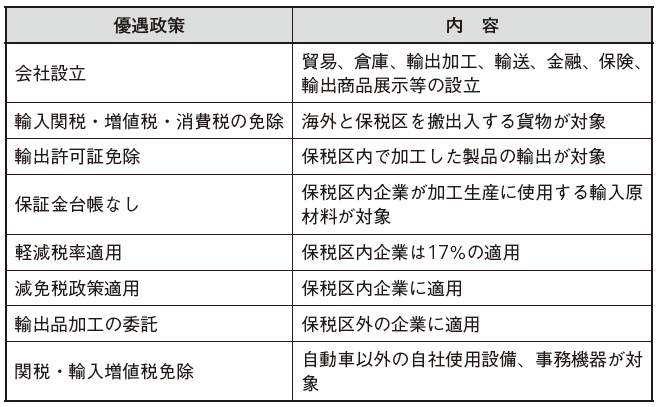
[Export Processing Zone]
An export processing zone is a specific economic technology development zone that is approved by the State Council and supervised by customs. Features of the export processing zone are mainly in its management system. For example, in terms of overseeing the cargo transported in and out of the export processing zone and related places (temporary storage place of cargo etc.) for 24 hours, companies in the export processing zone implement networking with the customs authority to carry out cargo data to exchange.
The purpose of setting up the export processing zone is to strengthen the processing trade management to standardize the customs supervision control, to promote development, and to encourage export of foreign trade.
The target of the export processing zone is a transportation company related to cargo carry-out or carry-in of export processing company, special warehouse company that provides services to products of export processing company, export processing area with customs approval. The commercial retail, general trade, relay trade and operations unrelated to the export processing zone are excluded.
The preferential policies of the export processing zone are as shown in the table below, but it is necessary to check individually when entering the country.
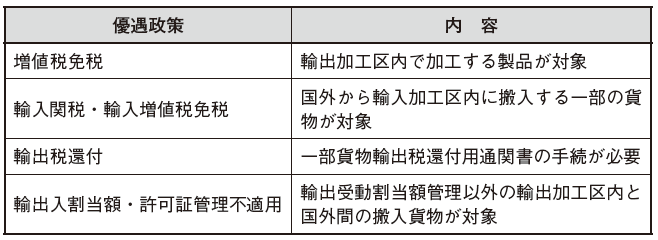
It can be cited that it is not possible to outsource the processing of products to a company outside the processing area as a point to pay attention to the export processing zone. When consignment is necessary, approval by the supervisory tax bureau is required.
[Logistics Park]
Logistics park area is a zone specialized in logistics that established within a bonded area or within a specified port area adjacent to a bonded area. This is also the customs supervised controlled area authorized by the State Council. The feature is that it is regarded as exporting when the domestic cargo enters the logistics park, and it is possible to refund the value-added tax. Currently, 8 sites are certified.
Regarding the management of cargo carry-in / out supervision, it is classified roughly into three.
Logistics Park and China
When cargo is brought from outside of China to the logistics park (hereinafter referred to as the park), notification management is carried out in the form of declaration of cargo to the customs authorities of the park according to the entry form for entry of cargo. The cargo to be exported from the park to the outside of the country, it is necessary to notify the customs authority of the park, but the export duty is exempted.
From the logistics park area outside the logistics park area
Regarding cargo carry-out from the park to the outside of the park, it is possible to declare in the zoo super administrative customs. When entering and leaving a small amount of freight frequently, the park enterprises can receive intensive clearance procedures by receiving approval from the administrative authorities of the park. The centralized customs procedure is a system that applies the execution tax rate and the exchange rate on the day when Customs accepts declaration of goods at the time of importing and exporting cargo every time. Procedures cannot be carried out across the fiscal year and must be completed within a month.
From the outside of the logistics park Distribution park zone
When cargo is delivered to the park from the outside of the park, we will authorized the cargo at the main administrative authority of the park depending on the type of cargo, it is necessary to submit a license. Refund of value-added tax is also permitted for cargo shipped from outside the park to the park. To apply for refund, attach the export freight entry declaration issued by the customs authority and other prescribed vouchers and perform procedures at the supervisory tax bureau.
Unlike bonded areas, the park is a specialized area for logistics. Production and processing in the region are not permitted (except for simple processing such as changing of packaging). The preferential policies of the logistics park are as shown in the table below, but it is necessary to check individually when entering into the market.
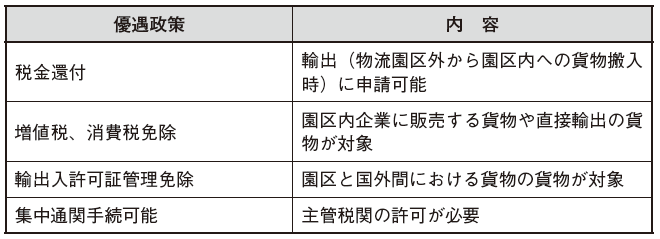
-
-
-
Local Information
In this section, we will describe the position, characteristics, and name of the enterprises in China for each province / city where many Japanese companies are entering.
■ Liaoning Province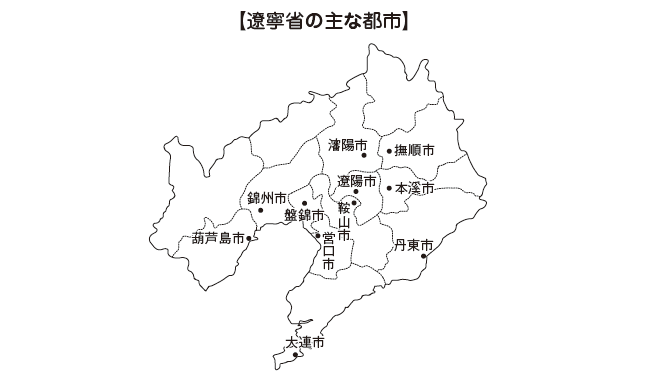
The population of Liaoning Province is 43.9 million (as of 2013). It is located in the northeastern part of China, the north is in contact with Jilin Province and Inner Mongolia Autonomous Region, but the southern part is the region where the Liaodong Peninsula protrudes facing the Bohai Sea and the economy which constitutes the Bohai Sea economic zone developed.
The province is rich in minerals such as iron ore and coal, and it is known as a province where heavy industry has developed. Liaocheon Oilfield is also one of the largest oil fields in the country.
Dalian City is the largest port city in the Tohoku district, and it is also the domestic heaviest chemical industrial zone. In the coastal area of Liaoning Province, cities such as Jinju, Dandong, Yingkou, Panjin and Shijiao are connected by beach roads called "five point one line" besides Dalian as industrial belt areas, many from Japan Companies are entering the market. In particular, there are many machinery and equipment manufacturing companies (Tsujimoto Kagaku Kogyo, Sankyo Co., Ltd. etc.). Dalian city plays a role not only in the Tohoku region of China but also as an international logistics base in Northeast Asia. It is connected with Qingdao city located opposite Bohai Sea by high speed cargo ship, and the air route is connected not only to domestic but also to local cities of Japan, Korea and Russia. It has a bonded area and promotes further hub formation in sea and airways.
Shenyang City is a provincial capital with a population of about 7.3 million people (as of 2013) with the development of machine industry and others. It was located in the inland and is the core city of the northeastern China which also serves as a gateway to Jilin Province and Heilongjiang Province. The Shenyang Economic Zone was approved as a new industrialization comprehensive reform test zone at the national level in 2010 and future development as an economic agglomeration of Northeast Asia is expected.
According to the Japanese Consulate General in Shenyang, there are 1,988 Japanese companies in Liaoning Province (as of May 2015), many of which are entering Dalian. In addition to the manufacturing industry, there are many metal products, chemical industry, and industries such as textile and food processing.
There are 6,750 Japanese living in Liaoning Province (as of 2015), of which 5,872 in Dalian City and 704 in Shenyang City. Dalian is known as a famous land pattern, there are many Japanese restaurants as well as Japanese Chamber of Commerce and Japanese schools. Anti-day demonstrations in various parts of China that began with the Senkaku Islands problem are said to have not occurred in Dalian.
■ Shandong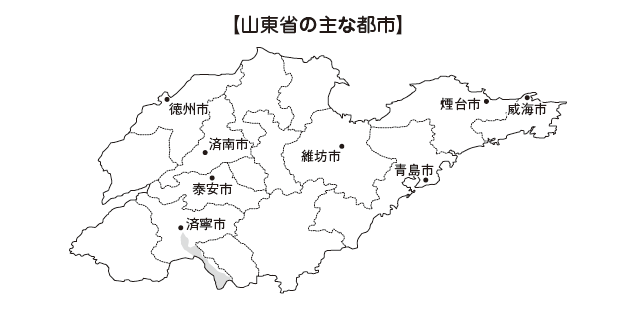
Shandong Province is located in northern China, with population of 97.33 million (as of 2013), provincial capital is Jinan. It is an area where industries developed with Beijing City, Tianjin City, Liaoning Province, etc. with the Pearl River Delta in Guangdong Province and the Yangtze River Delta called Shanghai and other parts of the Bohai Economic Zone.
The eastern part of the province has Shandong peninsula in Balhae and Yellow Sea, and has Qingdao city and Yantai city which are coastal open cities. There are many large and small harbors, and shipping trade which we are doing since long ago is a strength. Not only are agricultural products and marine products richly produced, but also have oil fields, coal fields, Jinshan, etc. and are blessed with mineral resources.
In Shandong Province, local industries such as textiles and food processing have been growing soon from the location that it is easy to import raw materials and export products easily, and the transportation infrastructure such as marine transport that has been aggressively promoted. Along with mining derived from mineral resources, heavy industry such as electric power industry, petrochemical, steel, machinery, shipbuilding etc. are also developed.
In recent years, it is famous for production base of two large home electric appliances manufacturers such as Haier (Haier) and Haisens (Haiyin), and the industrial structure is becoming more multilayered.
In the future, strategies for converting new industries such as the information industry and biotechnology field into a balanced industrial structure with light industry and heavy industries, which are already established, are launched on the national or provincial level. For example, there are industrial development based on marine resources as Shandong peninsula indigo economic zone, and development of advanced technology including renewable energy and modern agriculture as part of Yellow River Delta high efficiency ecological economic zone.
Since Shandong Province is close to the Korean Peninsula, many Korean enterprises have advanced, but Japanese companies are advancing various fields including electronic equipment.
According to the Consulate General of Japan in Qingdao that opened in 2009, there are 1,801 Japanese companies entering Shandong Province (as of 2013). The most common is Qingdao, then Yantai, other Jinan, Weifang, Jining, Weihai and many other cities. There are 1,879 people (as of 2013) residing in Qingdao. There are many Japanese restaurants, and Japanese schools have opened in 2004.

■Beijing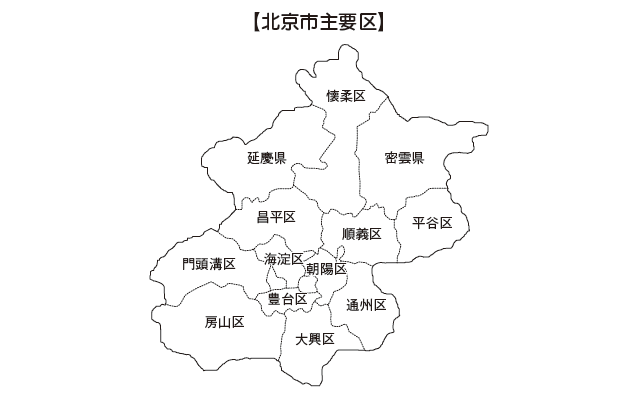
Beijing City is the capital of China and is one of political, cultural and economic centers, central government jurisdiction (a special city with provincial level authority). The population goes beyond the 20 million mark and reaches 21.115 million in 2013. It has a huge economic scale next to Shanghai and has an urban economic structure with a high rate of tertiary industry such as finance, information industry and service industry. Headquarters functions of each company are gathered and it is mega city which is the core of the centralized state of China.
Beijing therefore has several faces. One of them is the center of politics with Chinese central government agencies and embassies around the world. Next, as the center of the economy with financial centers where many financial institutions gather, including the central business area (CBO) with major multinational companies and major Chinese companies around the world and the head office of major Chinese banks I have a face. In addition to the Zhongguancun village called the Chinese version Silicon Valley, there are also faces of Pioneering University and Tsinghua University (China's universities are positioned as research institutes) and advanced science and technology areas with numerous R & D facilities. There are world cultural heritage such as Great Wall and Forbidden City, and there are faces of tourist cities visited by tourists from all over the world. On the other hand, there are problems due to rapid economic development and continued population growth.
Traffic infrastructure has been rapidly developed in line with the 2008 Beijing Olympic Games, and subway and expressways are being improved after that, traffic congestion is serious. Drive restrictions by the end of the license plate, etc. have been implemented, but we cannot keep up with the growing number of cars, and from December 2010 the number of new cars registered has been restricted to 240,000 a year. Some voiced concern about the negative impact on the economy, but it is an unavoidable measure.
The air pollution in Beijing is also very serious, and on January 13, 2013 the meteorological observatory will raise the warning to the highest level by raising the air pollution concentration of fine particulate matter such as PM 2.5 and so as to refrain from using or going out of the car I called on him. There are temporary factors due to weather conditions, but there are fundamental problems such as the sweetness of the automobile and its exhaust gas standards, and the large number of coal burning.
Drastic environmental measures and improvement in awareness of health damage are required and the water shortage is also serious. Since the amount of water stored in the two dams supplied to the city is less than half of the amount of water used by 20 million people annually, it draws a lot of groundwater and the lowering of the groundwater level is a problem. We have taken various measures such as accommodation from Hebei Province, Shanxi province, starting water intake from the Yellow River, promoting the use of recycled water, and desalinating high cost seawater but still lacking. In order to solve the fundamental problem, a national large plan is also in progress, "north south north tone adjustment" is raised, a national large plan that builds a waterway and carries water in the Yangtze River basin of south China to the north.
There are about 758 companies (as of March 2011) for Japanese companies that are entering Beijing, and 403 companies (as of 2011) only for listed companies. There are 13,637 Japanese residents residing in Beijing (as of October 1, 2013).
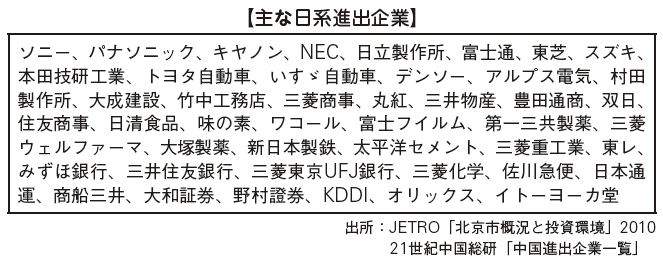
■Tianjin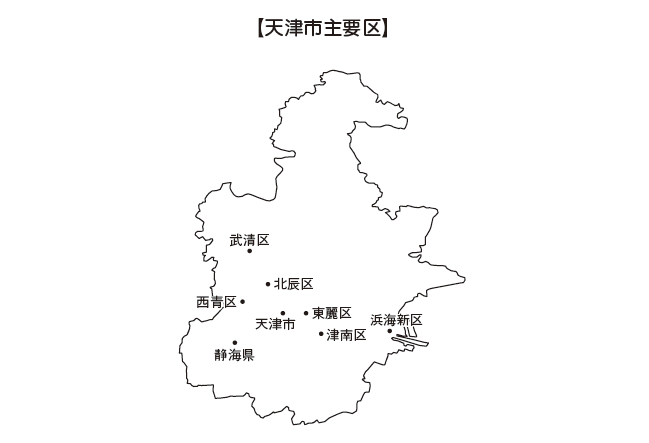
Tianjin is located in the northern part of China's China, facing the Balhae Bay next to Beijing, Shandong, Liaoning Province. It is a major city with a population of 147.2 million (as of 2013), one of the central direct jurisdictional cities alongside Beijing City, Shanghai City and Chongqing City.
Tianjin City is also one of the most industrial cities in the North China region, with a large industrial area and harbors. Companies in a wide range of fields ranging from machinery, electric machinery, and chemical industry to light industries such as textiles are located, and in the suburbs there are many industrial parks that are development zones. Large companies all over the world are entering the production base in China.
The logistics and service industries are also developed and there is a big presence as a commercial city. We also focus on promoting urban agriculture, research and development, and training of education fields, and we are switching to a mature urban economic model.
The GDP growth rate of Tianjin is 13.8% in 2012 and 10% in 2014, and it has achieved high growth. According to the "Urban Competitiveness Ranking of the World" by the research firm of the UK "Economist" (2011), Tianjin is the world's No. 1 economic competitiveness department.
There are 266 enterprises listed in Tianjin (listed in 2011) that are listed companies in Japan, and 3,157 people (as of October 2012) with Japanese residents increasing rapidly.

■ Jiangsu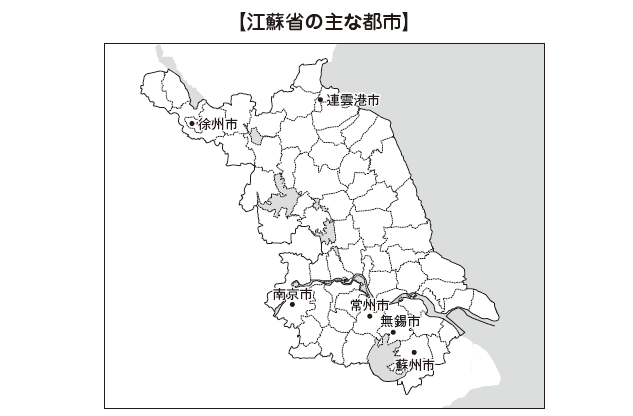
Jiangsu Province is located in the eastern part of China, with a population of 79.39 million people (as of 2013), GDP within the province occupies about 10% of the whole of China. More than half of the GDP comes from secondary industries, and industrialization is progressing in a wide range of fields such as machinery, electronic equipment, building materials, chemical industry, textiles, and food processing and so on. It is also active in nurturing high-tech industries.
The southern part of Jiangsu Province is located in the Yangtze River Delta spreading down the Yangtze River, adjacent to Shanghai city and Zhejiang Province where the economic development is remarkable. Especially, Suzhou city and Wuxi city located around Taihu Lake which is one of the five Great Lakes in China are close to the distance from Shanghai city, the relationship is close, the reform and opening up (China which began after 1978 After the reform of the domestic regime and open-door policy to foreign countries) foreign companies have entered early and have achieved remarkable economic development.
There are a number of Japanese companies and many enterprises entering Suzhou City and Wuxi City are 594 companies (as of 2011) only for listed companies, 10, 734 (as of October 2012) for Japanese residents only in Suzhou City Many Japanese people stay in Wuxi city and Nanjing city, too. In this region, the wage level rises remarkably with economic development, and average workers' average wages are the highest in China as in Shanghai, both Suzhou City and Wuxi City.
Many domestic and foreign companies have also advanced to Changzhou City located in the middle of Shanghai city and Nanjing City, Nantong City located on the other side of Shanghai side across the Yangtze River It was. The distance from Shanghai city to Nanjing city is 292 km, but now it is possible to move in Shanghai ─ Suzhou Wuxi ─ Changzhou ─ Nanjing belt area for 3 and a half hours on the highway, It has a presence as an economic area.
Xuzhou City, the central city of Jiangsu Province, has been growing in ethnic capital since ancient times, but now the introduction of foreign capital has progressed, and many large factories are in operation, including the United States, Germany, Japanese companies, etc. Food manufacturers in Japan are also in Lianyungang City, a port city facing the East China Sea, and economic promotion is proceeding in the north, but the fact is that the inter-ministerial disparities in the province are large.
■ Shanghai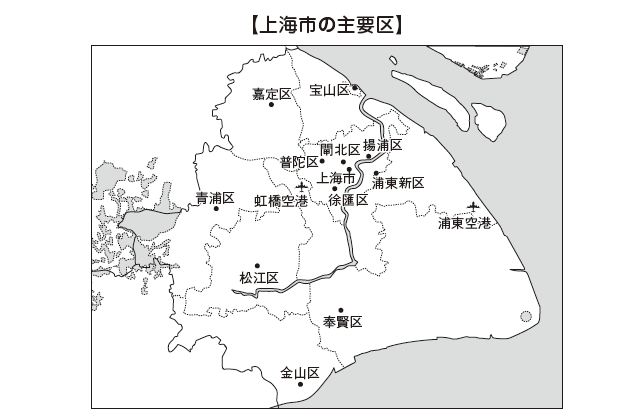
Shanghai is the largest city in China located in the eastern part of China, with a population of 24.15 million (as of 2013). It is also the center of the Yangtze River Delta, one of the largest economic zones, and it is a remarkable gigantic city with remarkable growth in all over the world.
Since the 1990s, many foreign enterprises have advanced and rapidly grown as industrial cities. After that, we shifted emphasis from labor-intensive production to high added value production such as high-tech industry, and third industry such as finance, retail, real estate grew and became a huge economic sphere like present. GDP per capita is in line with Beijing City, Tianjin City and over 80,000 RMB, which is comparable to developed countries.
Facing the Yangtze River, the Pudong New Area is an area where large-scale development has been undertaken since the 1990s, and many foreign companies have advanced, and there are also many Japanese companies.
In this area there are Lujiazui Financial Trade Zone with Shanghai Stock Exchange and R & D of Jinbashi Export Processing Zone where many high value-added products such as home appliances and precision machinery are exporting and exporting companies, medical and information equipment etc. Zhangjiang high-tech Park, four adjacent development zones of the outer Takahashi bond-free zone which became China's first bonded area adjacent to the Yangtze international seaport. Shanghai World Exposition held in 2010 with the prestige of China was also done by redeveloping Pudong New Area. Now it is Shanghai's new center of Tokyo where high-rise buildings stand, and it is thought that the presence will be increased as a global financial center in the future.
Shanghai is also a key to trade in China and East Asia. The state-of-the-art Yama mountain deep water which also corresponded to a super-large container ship.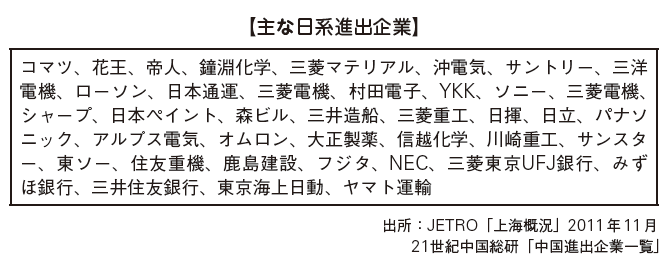
■ Zhejiang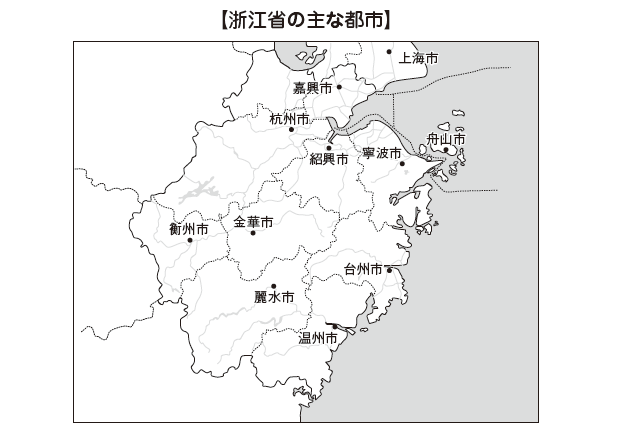
The northern part of Zhejiang Province is adjacent to industrial areas such as Shanghai city and Suzhou city of Wuzhi city in the southern part of Jiangsu Province, and rapidly industrialized after reform and opening up. It is a provincial agricultural province that is particularly active in the modernization of industries, such as the public internet network being maintained well. Industry is flourishing machinery, building materials, chemistry, textiles, food processing, etc. It is also famous for the production of heavy equipment such as polisher and generator.
There are more than 250 Japanese companies in Zhejiang alone by listed companies, many of which are entering Hangzhou city, Ningbo city, and Jiaxing city in the north. Hangzhou city of the provincial capital is a large city with a population of about 8.8 million people (as of the end of 2012) and trading is a thriving trading landscape. Advanced industrialization is progressing now. Ningbo City is the second industrial city in Zhejiang Province next to Hangzhou City and is also the core shipping center with the third largest port of China after Shanghai and Shenzhen. In addition, located in the middle of Shanghai city, Hangzhou city, Ningbo city, Suzhou city, there is a Pinghu economic development zone, which is a Japanese company investment zone in Jiaxing City, which is one hour by car from either city. We actively attract advanced information industries such as electronic parts and precision machinery.
In the year 2008, the Hangzhou Bay Bridging Bridge was built over the Hangzhou Bay connecting with the Jiaxing City and Ningbo City. The time required from Shanghai city to Ningbo City was to shortened from 4 hours to 2 hours, the transportation convenience in the northern part of Zhejiang province improved markedly and regional trade was promoted.
■ Fujian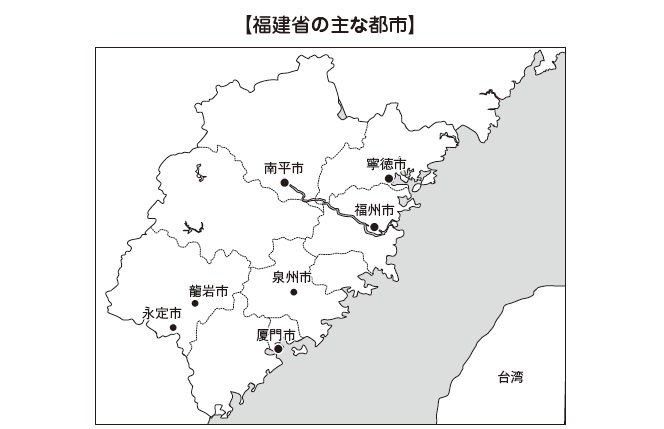
Fujian Province with a population of 37.75 million (2013) is located in the southern part of China, with Zhejiang Province in the north, Guangdong Province in the south and Taiwan across the strait in the east.
It is a lush green province with a forest coverage rate of 62.9% or more, with mountainous land patterns near the coast and a slightly flatland in the inland basin. Besides being known as a scenic spot, it is famous worldwide as a production center for oolong tea and granite. The coastal area is a 3,300 km rias type coast, with port city such as Quanzhou City, Xiamen City dotted with Fuzhou City which is the provincial capital.
Fujian Province, together with Guangdong Province, is known as a hometown of overseas Chinese, and there are millions of Fujian Chinese figures throughout the world. In history, there are residents' migration from Fujian Province to Taiwan several times, that is why there are many people in Taiwan that have Fujian roots which resulted that we have a strong relationship with Taiwan and that we have a lot of investment in Taiwanese companies.
The economic promotion of Fujian Province started with the transition to the reform and opening policy in the 1980s and the relaxation of the tension in the Taiwan Strait. Starting with Xiamen City's Special Economic Zone designation, now all of the coastal areas of Fujian Province are coastal economic open areas. While there are also foreign companies such as Japanese companies, there is a strong tendency that local industries and Taiwanese capital are led by.
Major industries are petrochemical, machinery, electronics and electricity, but export dependence is not as high as in Guangdong province. As a local industry agriculture, forestry and fishery processing has been active for a long time, tea, refined sugar, paper making is top class all over the country. There are 193 Japanese companies in 2012 (as of 2012) and 81 companies as limited companies (as of 2011), of which 36 in Fuzhou city, 38 in Xiamen city, 934 in Japanese residence (2011 As of October of the year) has become.

■ Guangdong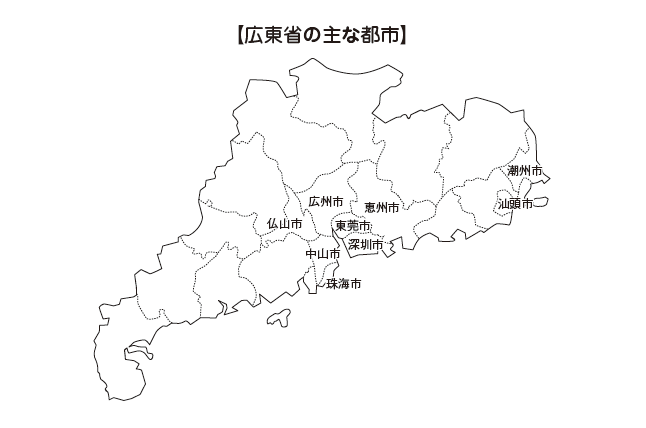
Guangdong Province is located in the South China region and is a temperate region facing the South China Sea. The population of the province is 164.4 million (as of the end of 2013), and GDP is 62,164 billion yuan (as of 2013), which are all nationwide.
Triangle area and Guangzhou area located in the mouth of the Pearl River, which connects Guangzhou City, Hong Kong and Macao and its surrounding area is called Pearl River Delta, and is a major economic zone that has led the reform and opening up of China.
In 1980, Shenzhen City, Zhuhai City, Shantou City, which is adjacent to Hong Kong, was opened as a special economic zone right after the beginning, in 1984 it became a coastal city such as Guangzhou City, and in 1985 the entire Pearl River Delta became an open economic zone.
The market economy has been introduced since reform and liberation, foreign capital has advanced, and has achieved remarkable economic growth. There are various industries such as food, textile, chemical industry, medicine, electronic / electric equipment, machinery and so on. Especially the production of household electric appliances such as televisions, refrigerators, microwave ovens is the best in China.
Guangdong Province is a region where processing trading by Hong Kong-based enterprises is thriving, Japanese companies also advanced mainly processing trade until the 1990's. Currently, industries requiring local procurement such as parts are expanding, the spread of the base of the manufacturing industry, and furthermore, production for the domestic market increased with the expansion of domestic demand, transforming from the economic structure that depended on processing trade I'm doing it.
There are about 1,934 Japanese companies entering Guangdong Province (as of October 2012) and 872 listed companies alone, of which 250 in Shenzhen City, 292 in Guangzhou City and 116 in Dongguan City I will. In addition, many Japanese companies, such as electronic and electrical equipment and chemical industry, are also advancing to Foshan city, Nakayama city and others. Japanese people living in Guangdong province will be 16,726 people (as of October 2011).
[Shenzhen City]
Shenzhen is adjacent to Hong Kong, where it was 40 minutes by train from Kowloon, 1 hour from Guangzhou There is a geographical advantage of the city, and the market economy was introduced as the first special economic zone in China.
Foreign companies of electronic equipment and household appliances have advanced from early on. The accumulation of high-tech industry is progressing now.
The Shenzhen City is the only port city with land, sea and empty customs in China, with Shenzhen Port, the fourth largest container (2011) worldwide, and is in an important position both inside and outside as a logistics base. It is also characterized by the fact that the service industry is prosperous, the Shenzhen Securities Exchange, the second largest stock exchange in China, has a financial base in the South China region. Because the profit rate of the conventional manufacturing industry has declined, the conversion to an industrial structure focused on tertiary industry is proceeding.
There are 103 Japanese companies in Shenzhen alone (as of 2013), and the number of Japanese residing in Japan is 4,730 (as of October 2011)
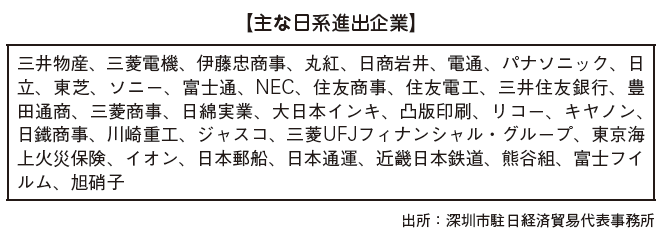
[Guangzhou City]
Guangzhou City is the center of politics and culture as the provincial capital of Guangdong Province with the population of 12.84 million people (as of the end of 2012) that developed transportation networks such as subway and highway. It was located in the center of Guangdong province, and is characterized by good access with each city of Pearl River Delta.
Heavy industries such as shipbuilding, iron and steel, machinery, petrochemical, etc. are taking advantage by developing the necessity of water transport, but we are also focusing on cultivating high added value industries such as precision chemistry, medicine and information industry. Currently, many automobile industries such as the United States and Germany are advancing.
There are 292 Japanese companies that are entering Guangzhou City only for listed companies. There are 7,010 Japanese residents (as of October 2012), Japanese schools and the Consulate General of Japan in Guangzhou.
[Dongguan City]
Dongguan City is located between Guangzhou City and Shenzhen City, about 100 km north of Hong Kong. As Hong Kong citizens with roots in Dongguan City are many, Hong Kong companies have been actively investing in processing trade in textiles, electronics and electricity after reform and opening up. After that, Japanese electronic equipment parts makers, Taiwan-style PC parts manufacturers, and European mobile phone manufacturers have advanced one after another, making it a major production base for personal computers and mobile phone terminals.
[Huizhou City]
Huizhou city is adjacent to Shenzhen City and Dongguan City, and many Hong Kong companies have produced home appliances right after the reform release. Headquarters of the TCL Electronic Group was set up, Phillips in the Netherlands, major Japanese and Korean electronics manufacturers advanced, and became a site for the collection of electrical and electronic equipment. The industrial structure has been expanding in recent years, such as establishing a digital industrial park to attract high-tech enterprises, and joint venture petrochemical plant with shell started operation.
-
-
-
Investment authority and authority
When introducing foreign capital, the institution that examines and approves depending on the size of the investment differs.
The Commerce Department of the State Council, which is the central government, and the Commerce Department of the local government delegated by the Ministry of Commerce, are divided into two main sections:
The central government has the authority to approve the introduction of foreign capital for "incentives and permission items with investment totaling over US $ 100 million, or limit items with investment totaling over US $ 50 million". Meanwhile, the local government has the authority to approve the introduction of foreign capital in "incentive classes and permission items with investment totaling less than US $ 100 million, or restriction category items with investment totaling less than US $ 50 million".
A detailed administrative institution has been established for the introduction of foreign capital by the State Council which is the central government, not only authority is given to the Ministry of Commerce, but roles vary from institution to institution.
Specific organizations and their main roles are as follows.
Commerce Department
· Establishment of enterprise · branch · establishment establishment
· Company's clearing authorization
· Approval of transfer of equity interest
· Approval or registration of technology introduction contract with foreign company
· Import permission approval for importing permission management commodity such as silver spot investment equipment
· Authorization at the time of export of export license management products of enterprises
State Industry and Commerce Administration Administration Bureau
· Certification of provisional registration of company name before enterprise establishment
· Approval of business registration and registration of office registration and promulgation of business license
· Conducting annual inspections on registered companies and accepting reports of financial statements etc.
National Foreign Exchange Administration Bureau
· Acceptance of application for registration of foreign bonds of company and issuance of registration certificate
· Investigation of foreign currency income report from companies and acceptance of major financial reports
· Foreign currency year inspection conducted
· Acceptance of corporate foreign currency account opening report
· External debt notification acceptance
Customs offices
· Import and export management of goods etc.
· Customs duties of import and export cargo etc
Tax department
· Acceptance of corporate tax registration
· Corporate tax administration
· Tax survey of companies
Finance Bureau
· Acceptance of financial statements prescribed by the company
Land Management Bureau and State-owned Assets Management Bureau
· Acceptance of land use rights · Building related payments and transfer · collateral registration
· Contract approval for land use rights transfer or land lease
· Land use permit issuance
· State-owned asset value evaluation -
Discontinued incentives
Although China was taking tax incentive measures for foreign-affiliated companies, the preferential tax rate stipulated for each open area has been abolished from 2008, following the Corporate Income Tax Law enforced in January 2008.
Instead of distinguishing the tax rates from the internal and foreign capital, we switched the incentives to the industrial field that Chinese Government and the market economy was pointed out in China.
Until then, there was a difference of about 10% in the effective tax rate on Chinese average domestic companies (internal capital enterprises) and foreign-owned enterprises on average in China. The amount of tax relieved annually by foreign-funded enterprises before revision is about 50 billion US dollars.
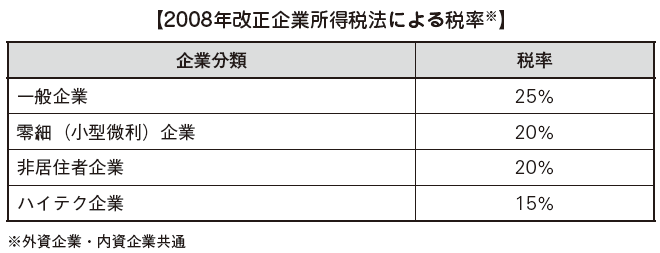
-
Regulation on foreign investment
Foreign investment restrictions on China are carried out based on the foreign investment industry guidance catalog. This catalog has been revised six times has come into effect on April 10, 2015 and has been applied.
Foreign capital was regulated based on the encouragement, restriction and prohibition list of foreign investment (hereinafter referred to as the original catalog) published in 1989 until the new inventory was enforced in 2012. In the former catalog, the priority of regulation has been set for each industry and each product item as industry-specific policies for introducing foreign investment.
In 1995, provisional guidance for foreign investment direction was newly established on the basis of the original catalog principle, at the same time a foreign investment industry guidance catalog was also released. With this inventory, industry-specific policies on the introduction of investment by the Chinese government became clearer.
Furthermore, on February 11, 2002, the State Council promulgated the foreign investment direction guidance provision (hereinafter referred to as a new provision). At the same time, the catalog of foreign investment industry guidance was also revised and published on March 11, 2002 by the National Development Planning Committee, the National Economic and Trade Commission, and the Foreign Trade and Economic Cooperation Department (now the Ministry of Commerce). Later, in 2004, 2007, 2011 and 2015 the foreign investment industry guidance catalog has been revised.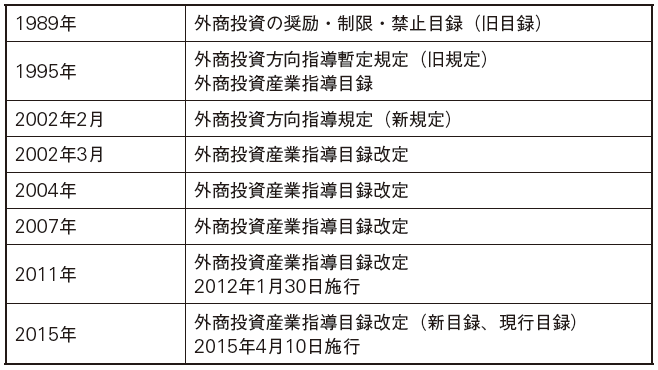
The China Development and Reform Committee decided to establish a new economic system at the 3rd Central Conference of the 18th Chinese Communist Party and revised the Foreign Investment Industry Inventory with the Ministry of Commerce. Compared to the 2011 version before the revision, the new catalog, although the basic items remain the same regardless of the stability of the policy, modern agriculture, high-tech, energy conservation and environmental protection, new energy, advanced manufacturing and service etc. It was newly added. Restrictions were relaxed considerably and it was changed from 79 items to 38 items. Items with restricted foreign ownership equity were deleted from 43 items to 15 items. The prohibited category has been changed from 39 items to 36 items.
In the current new inventory, it is classified as encouraged, prohibited or restricted depending on regulation content. Below, we explain each regulation.
■ Regulated Industry / Prohibited Industry
[Prohibited kind]
It is prohibited to invest in projects corresponding to the following items.
· Those that harm the national security or impair the interests of society and the public
· Those that harm environmental pollution, natural environment destruction, or human health
· To occupy a large amount of arable land, to disadvantage the protection and development of land resources, or to harm the safety and function of military facilities
· Produced by country's unique manufacturing process or technology
· Other projects prohibited by the laws of the country or administrative regulations
Some of the items belonging to the prohibited category in the former catalog such as the establishment of a futures trading company were changed to the restricted class or permitted type in the new inventory. Specifically, the construction and management of the villa has been changed from restricted type to prohibited type, domestic mailing work of the letter has been added to the prohibited category. The import business of books, newspapers, periodicals, audio products, and electronic publications has been removed from the prohibited category.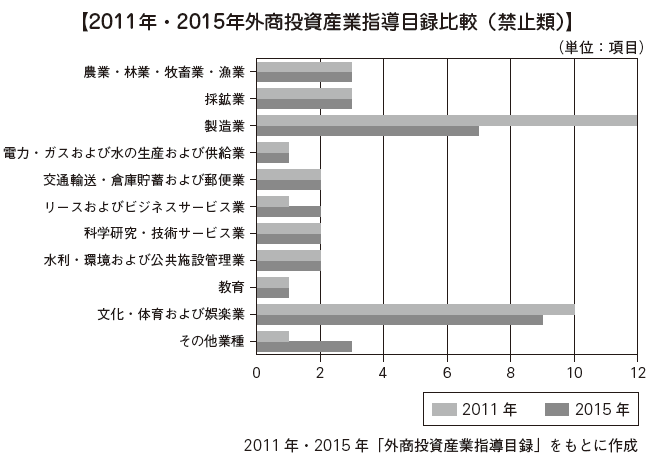
[Restrictions]
When investing in a project that falls under the category of restriction, 100% of foreign capital will not be accepted and investment will be limited. However, if the total investment ratio of investment by Chinese investors in foreign investment project is 51% or more, we can invest in restricted industry in the form of Sino-foreign joint venture Company.
In the new catalog, restrictions on the share of foreign ownership of steel, ethylene, paper, crane machinery, transmission and transformation equipment, coal chemical equipment, small helicopter, automobile, white wine, etc. are abolished in the new catalog. As a result, general manufacturing industry can basically enter foreign capital unless the following situation is satisfied.
· Late technical level skills
· Disadvantages to resource saving and ecological environment improvement
· Exploration and mining of specified minerals that the country regulates the implementation of protection mining
· Belonging to industries in which the country opens in stages
· Other circumstances prescribed by laws, administrative regulations
As of 2007, the manufacturing industry saw expansion of items due to chemical raw materials, chemical manufacturing, non-ferrous metals, etc. Meanwhile, in the service industry, wholesale and retail trade excluding net sales etc., commodity lease, freight transportation agency, etc. were out of limitation, reflecting the fact that market opening due to WTO accession penetrated into the service field.
The revision in 2011 relaxed entry of foreign capital by manufacturing industry. Specifically, there is no limitation on "production of natural food additives and food additives", "production of new energy power plants or major equipment" as "limited to joint ventures and collaborations". Restrictions are also abolished with regard to irrigation, environment and public facilities management, sanitation, social security and welfare services.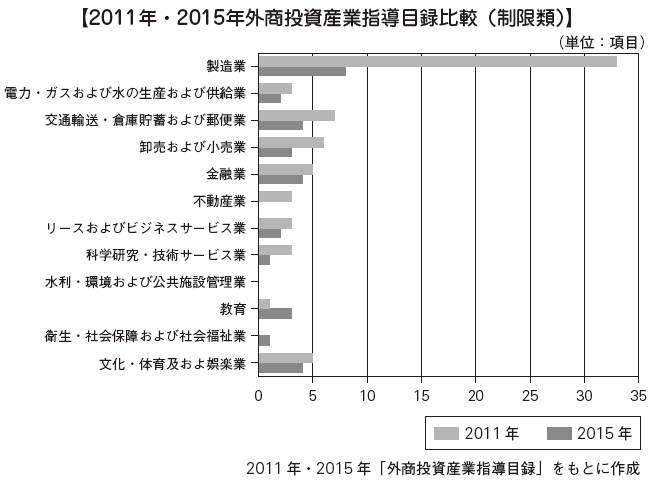
-
Land system and assignment / relocation
In China, the concept of rights on land is divided into two: ownership and usage rights.
Basically, the land of a city is owned by the country and it reflects socialism strongly. When entering China it is important to have a grasp of the land system surely.
Stated in the People’s Republic of China, Article 10 of the constitutional, ownership of the land is said to be either all ownership of the people or group ownership. All-people ownership means owned by the state, collective ownership means ownership of farmers' groups.
There are two types of land use authority, national land use rights and collective land use rights. State-owned land use rights are further classified as allocated land use rights and payable land use rights.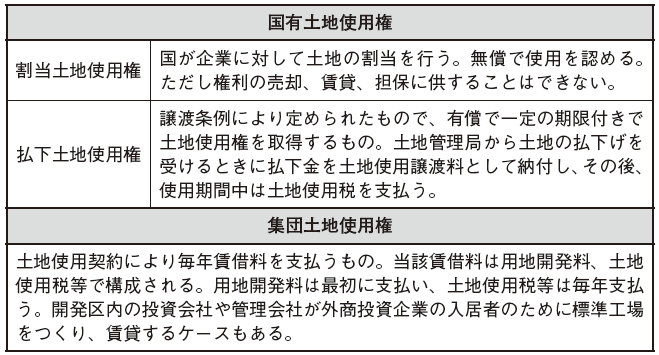
Bidding, auctioning and public notice system has been adopted from 2007 in order to acquire payable land use rights. Previously there were three ways of consultation, bidding, auction, but it was changed to prevent agricultural land protection, unplanned investment and low level duplicate construction. If you acquire land use right, you can also rent, set collateral, and transfer. However, the upper limit of the land use period is determined for each purpose.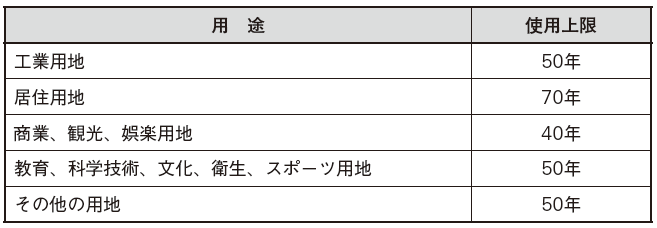
The use of Chinese land is strictly controlled. If you divide the use of land into agricultural land, construction land, unused land, and use it for purposes other than the use of the determined land, you must take the application change procedure. However, strictly the area for the purpose of the land is stipulated in China, making it impossible to easily change the purpose.
When Japanese companies use land in China, do not forget that they are only given the right to use land from the state. There are cases in which Japanese companies' eviction of recession broke out without understanding the system. Unlike Japan, private ownership of land is not permitted in China, so there are only two ownership rights of all people's ownership and group ownership.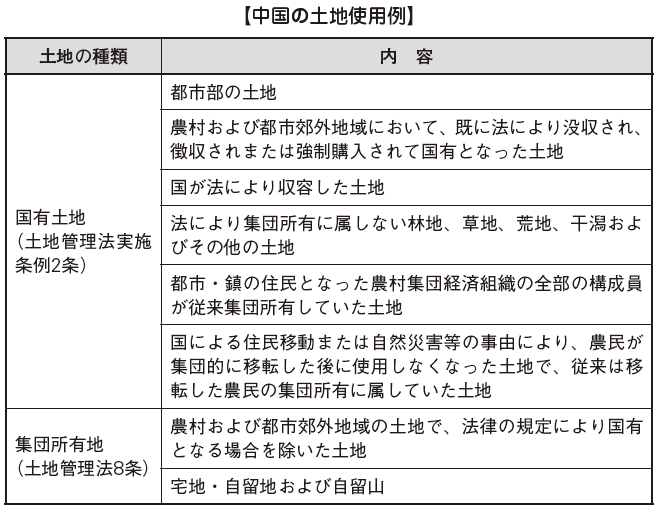
With respect to idle land of two years or more, in the idle land treatment regulation (Land Resource Division Ordinance [1999] No. 5)] "20% of land price when land construction cannot be started even after more than 1 year after land acquisition" It is stipulated that when the land must be paid for the equivalent of the land and the land is not used for the second consecutive year, the government collects the land free of charge ". There is an example that local government requested collection from the strengthening of land management. Furthermore, the Land Management Act revised in August 2004 (Presidential Decree [2004] No. 28) has provisions permitting "export by the country based on public interests and urban planning, etc." There are cases where foreign companies including companies have been forced to expropriate and relocate after their establishment. In recent years it is necessary to keep in mind that the prescribed operation is being tightened. -
Management system of state-owned assets and evaluation system
The management system of state-owned assets plays an important part in the national economy. It has the property that it is restricted by the economic system, and it will be revised along with that change. At the 16th Communist Party Conference in November 2002, the following five items were reviewed on the management system of state-owned assets made during the planned economic age.
Establishment of an institution specialized in independent state-owned asset management under the control of the State Council
· Unification of decentralization system in state-owned asset management and centralization of authority and responsibility of state-owned asset management institution
· Decentralization of investment rights by central government and local government
· Restrictions on government administrative interventions on state-owned asset management
· Redefining that state-owned assets are balanced with social adjustment functions, examining the form of state-owned assets
In response to this review, China's state-owned asset supervision and administration committee was established in April 2003.
State-owned assets are the following assets.
· Assets acquired or certified by law by law
· The state invested in companies in various formats and investment income
· Assets formed by the state issuing fiscal funds to administrative units
State-owned assets may leak out in the following cases.
· Record inappropriate amount for asset value
· Resale to other with low price
· Set resale price for resale of free state-owned assets and reselling to management team and purchase by themselves
· Out-of-record due to insufficient management, uncollected investment assets
In order to avoid such outflow of state-owned assets, the management system was reviewed, and in January 1996 the corporate state owned property ownership registration control law was enforced. Its main purpose is as follows.
Enhancement of registration in state owned property ownership of enterprises
Regarding ownership registration, the annual inspection system is being implemented. Within 90 days after the end of each fiscal year, we perform the ownership period inspection procedure and submit the financial report and the state-owned asset management year report to the state-owned assets management department. This report includes the actual payment status of the investor's funds, changes in composition of state-owned state assets, changes in state-owned assets, etc.
Strengthening the fundamental management system of state-owned assets
The authority to manage and supervise state-owned assets is in the department of state-owned asset management administration. However, the statutory evaluation is not carried out directly by the department of the state-owned asset management administrative department, but it is carried out by the evaluation agency certified by the department of state-owned assets management administration. For example, it is a state-owned asset valuation company, accounting firm, appraisal office, financial advisory company etc.
In principle, the state-owned asset management administrative department of the central government or the local government recognizes the evaluation qualification to China's asset valuation company, accounting office etc.
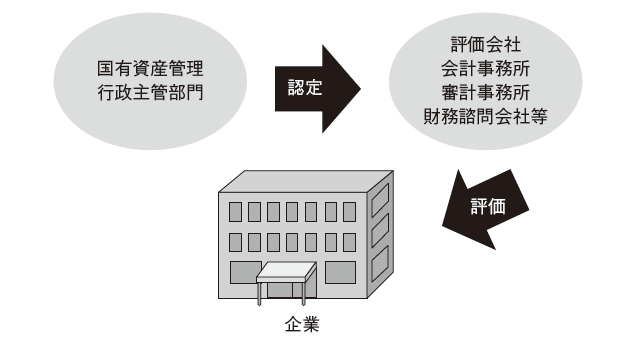
Prevention of outflow of state-owned assets
Regarding the prevention of outflow of state-owned assets, there is provision on the procedure of asset evaluation. Evaluation of state-owned assets is not necessary for all assets. It is necessary for joint venture or cooperative enterprise establishment, when Chinese side invests physical investment by state-owned asset, when foreign side acquires the interest of China side.
Prescribed in the Rules for Evaluation of State-owned Assets, corporate value evaluation methods mainly applied in China include income approach (value of enterprise calculated based on future predicted profitability), cost approach (value of company B / S), market approach (calculated value of company compared to listed company) There are three.
There is also a liquidation price method that evaluates at the disposal price at the time of liquidation, but the evaluation method described above tends to be used. -
Incentive
■ Industry
Among the items that were classified into four categories in the Foreign Investment Industry Instruction Catalog (New Catalog) (Encouragement, Permission, Restriction, Prohibited Classification), the requirements that can be encouraged are as follows.
· Agricultural New Technology · Agricultural Comprehensive Development and Energy · Transportation · Important Raw Material Industry
· To belong to high-tech, advanced and usable technology, to improve product performance, to enhance the technical economic profitability of enterprises, or to produce new equipment and new materials short in production capacity in the country Belongings
· To adapt to market needs, to enhance product grades to develop emerging markets, or to increase the international competitiveness of products
· Those that can save new technologies, new equipment, energy and raw materials, comprehensive use of resources, regeneration of resources and prevention of environmental pollution
· To demonstrate the superiority of human resources and resources in the Midwest area and meet the national industrial policy
· Other projects stipulating incentives by national laws and administrative regulations
If it falls under any of the above, it falls under the category of encouraged foreign investment project. In the new catalog, the manufacturing industry, which is the advanced field among manufacturing industries, is regarded as an important promotion item. Advanced fields are environmentally friendly technologies, for example, environmental friendly technologies such as clean production and energy saving in the spinning and chemical industries.
In the revision in 2007, the item "limited to the Midwest area" was deleted regarding the superiority of human resources and resources, but there is no change in the policy to promote development in the Midwest and the Tohoku region. It is a premise that the encouragement field of these areas is to be incorporated into the "Midwest area, foreign investment superior industry guidance inventory" to be revised in the future.
The revision in 2011 is characterized by the reduction of resource consuming industries (high and low capital), which consume a lot of energy and have a high burden on the environment. In response to this revision, we are promoting the Environmental Protection Bureau to the Environment Department to regulate both parties, increasing the budget for environmental measures.
Specifically, the Council Directorate of the Development and Reform Committee of the Department of Development and Reform Committee notified the approval / transfer of some opinions on the excess capacity of production and redundant construction of construction and induction of industrial sound development (promulgated by the State Council on September 26, 2009) , Six industries, iron and steel, cement, plate glass, coal chemical industry, polycrystalline silicon, and wind power generation equipment, were positioned as industries with severe production capacity and severe construction. As a result, the coal chemical industry and the production of polycrystalline silicon were excluded from the incentives. Even in wind power generation facilities, in order to improve the quality of entry into foreign capital, the condition to be accepted as an encouragement type was raised from the conventional 1.5 MW or more to the wind power generation equipment of 2.5 MW or more by this revision.
Meanwhile, new fields such as spinning, chemical industry, machinery manufacturing, etc. are newly added as encouraging types in order to make great use of foreign technologies and new products and to increase the added value of domestic manufacturing industry. In China it is problematic that the production capacity will be excessive. In areas excluded from incentives, as companies are going bankrupt or as construction remains unchanged, employees are forced to go unemployed and the economic effect of banks' bad loans is expected to improve, so the government has decided that this notice I promulgated.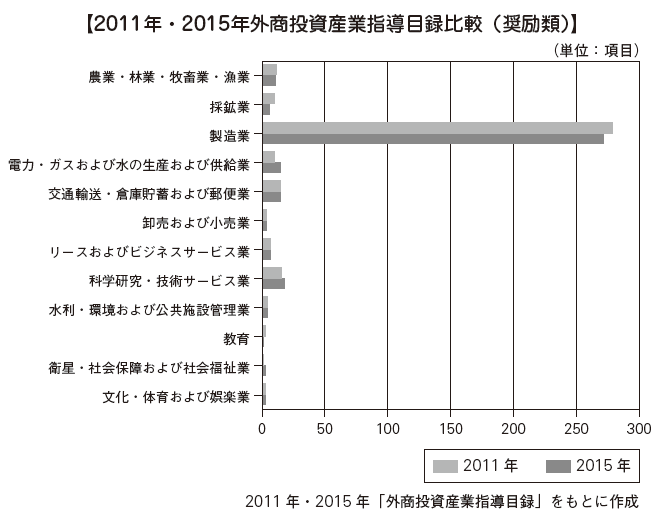
-
Economic trade agreement
The Closer Economic Partnership Arrangement (CEPA) is an agreement that was signed between Hong Kong and Mainland China on June 29, 2003, and came into effect on January 1, 2004. It is the content that carries out foreign favorable policy that exceeds the commitment of China when joining the WTO, such as early deregulation at the entry into the Chinese market.
CEPA is practically the same as the Free Trade Agreement (FTA), but since China and Hong Kong are not countries, they are one country and two systems. Therefore, it is not a free trade agreement but it is CEPA.
This agreement has three features.
Customs duties on Hong Kong products
China aims to gradually reduce or eliminate tariffs and non-tariff barriers in Hong Kong products in almost all cargo trade.
Liberation of service industry in 18 areas
China provides Hong Kong companies with a wide range of services including advertising, accounting, music video, banking, construction / real estate, conference / exhibition, distribution, cargo agency, insurance, law, logistics, management consulting, medical / dental, securities, warehousing, , Relaxing regulations in 18 areas of transportation. However, in order to receive preferential policies, it is essential to be certified as a Hong Kong company. In order to be recognized as a Hong Kong company, it must satisfy all of the following requirements.
· 3 to 5 years have passed since establishment
· Pay corporate income tax
· Employ more than 50% of local employees
Improve trade and investment efficiency
The purpose of this agreement is to cooperate with mainland China and Hong Kong in the following items and to improve the efficiency of procedures.
· Promotion of trade and investment
· Improve customs clearance
· Product inspection · quarantine, food safety, quality, standardization
· Introduction of e-commerce
· Improvement of transparency of regulations
· Strengthening cooperative relationships among SMEs
· Cooperation in the field of medical products, such as traditional Chinese medicine
-
-
-
Websites
[1] THE WORLD BANK ‘DOING BUSIESS ‘Smarter Regulations for Small and Medium-Size Enterprises, 2013’
[2] 佐野淳也「注目される中国の為替政策」アジア・マンスリー、2011年3月号
[3] 日本貿易振興機構(ジェトロ)海外調査部中国北アジア課「中国GDP世界第2位時代の日本企業の対中ビジネス戦略」2011年3月
[4] 陳建安「中国の海外直接投資受入の経済的効果とその政策調整」
[5] Klaus Schwab ‘The Global Competitiveness Report 2013-2014’ World Economic Forum
[6] JBIC「中国投資環境シリーズ(総論編)」2013年8月
[7] 国土交通省「世界の港湾別コンテナ取扱個数ランキング(1980年、2013年(速報値))」
[9] 「2010年の中国通信環境についてあれこれ」ASCII.JP×デジタル、2011年2月11日
[10] JETRO
[11] 在瀋陽日本総領事館「東北三省における在留邦人数及び日系企業数の推移」
[12] 外務省領事局政策課「海外在留邦人数調査統計〈平成24年速報版〉」平成23年10月1日現在
[13] 財団法人自治体国際化協会北京事務所「中国の水事情」CLAIRREPORTNo.361(2011年6月11日)
[14] 一般社団法人日本港運協会「取扱量1000万TEUを超える世界のコンテナ港湾」
[15] 日中経済発展交流会「福建省」
[16] 日本国駐広州総領事館「福建省主要データ」2015年3月現在
[17] 大泉啓一郎「地域間人口構成の格差が広がる中国」アジア・マンスリー、2012年8月号
[18] 深圳市駐日経済貿易代表事務所
-
Babiliography
[1] 21世紀中国総研編『中国進出企業一覧上場企業篇』〈2013-2014年版〉蒼蒼社、2013年
-



 Japan
Japan UnitedStates
UnitedStates China
China Hong Kong
Hong Kong Mongolia
Mongolia Russia
Russia Thailand
Thailand Vietnam
Vietnam Laos
Laos Cambodia
Cambodia Myanmar
Myanmar Indonesia
Indonesia Philippines
Philippines Singapore
Singapore Malaysia
Malaysia India
India Bangladesh
Bangladesh Pakistan
Pakistan Sri Lanka
Sri Lanka Mexico
Mexico Brazil
Brazil Peru
Peru Colombia
Colombia Chile
Chile Argentina
Argentina DubaiAbuDhabi
DubaiAbuDhabi Turkey
Turkey South Africa
South Africa Nigeria
Nigeria Egypt
Egypt Morocco
Morocco Kenya
Kenya